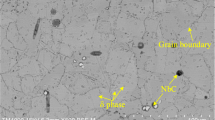Abstract
The characteristics of Inconel 718 alloy pose major challenges during the machining process. The following study aims to improve upon the product quality and machining productivity of the material by using polycrystalline cubic boron nitride (PcBN) tools and discrete machining. The use of PcBN tools offers benefits of sustainable and economical manufacturing. The experimental setup involved high-speed milling machine, a piezo-electric actuator and data acquisition software. This manuscript unveils a new flank wear assessment model that is applicable to a discrete machining process. The mathematical analysis develops a flank wear assessment for discrete machining and cutting speed parameters for Inconel 718. The cutting conditions were as follows: cutting speed, discrete machining frequency, feed per tooth and depth of cut. The tool-work interface process behaviors were evaluated in terms of the following: cutting forces, surface hardness, surface finish, surface texture, chip morphology and flank wear. The role of discrete machining allowed for a decrease in cutting forces and an improved surface finish and surface texture. The withdrawal of the tool allowed for the oil-air mist coolant to reach the heat-affected zone, thus reducing the severity in the heat-affected zone.
Similar content being viewed by others
References
Ulutan D, Ozel T (2011) Machining induced surface integrity in titanium and nickel alloys: a review. Int J Mach Tool Manu 51:250–280
Nee AY (2015) Handbook of manufacturing engineering and technology. Springer, London
Sharman A, Dewes RC, Aspinwall DK (2001) Tool life when high speed ball nose end milling Inconel 718. J Mater Process Technol 118:29–35
Khan S, Soo S, Aspinwall D, Sage C, Harden P, Fleming M, White A, Saoubi R (2012) Tool wear/life evaluation when finish turning Inconel 718 using PCBN tooling. Procedia CIRP 1:283–288
Connolley T, Reed P, Starink M (2003) Short crack initiation and growth at 600 C in notched specimens of Inconel 718. Mater Sci Eng 340:225–233
Schornik V, Zetek M, Dana M (2015) The influence of working environment and cutting conditions on milling nickel-based super alloys with carbide tools. Procedia Eng 100:1262–1269
Mann J, Saldana C, Moscoso W, Compton W, Chandrasekar S (2009) Effects of controlled modulation and interface tribology and deformation in machining. Tribology Letter 35:221–227
Yeung H, Sundaram NK, Mann JB, Compton W, Chandrasekar S (2013) Energy dissipation in modulation assisted machining. Int J Mach Tools Manuf 74:41–49
Mann J, Guo Y, Saldana C, Compton W, Chandrasekar S (2011) Enhancing material removal processes using modulation-assisted machining. Tribol Int 44:1225–1235
Gaitonde VN, Karnik SR, Luis F, Paulo Davim J (2011) Performance comparison of conventional and wiper ceramic inserts in hard turning through artificial neural network modelling. Int J Adv Manuf Technol 52:101–114
Gaitonde VN, Karnik SR, Luis F, Paulo Davim J (2009) Analysis of machinability during hard turning of cold work tool steel (type: AISI D2). Mater Manuf Process 24:1373–1382
Gaitonde VN, Karnik SR, Luis F, Paulo Davim J (2009) Machinability investigations in hard turning of AISI D2 cold work tool steel with conventional and wiper ceramic inserts. Int J Refract Metals Hard Mater 27:754–763
Quiza R, Luis F, Paulo Davim J (2008) Comparing statistical models and artificial neural networks on predicting the tool wear in hard machining D2 AISI steel. Int J Adv Manuf Technol 37:641–648
Figueira L, Paulo Davim J (2007) Comparative evaluation of conventional and wiper ceramic tools on cutting forces, surface roughness and tool wear in hard turning AISI D2 steel. J Eng Manuf Proc IMechE, Part B 221:625–633
Stolarski T (1999) Tribology in machine design. Butterworth-Heinemann, Oxford
Usui E, Shirakashi T (1984) Analytical prediction of cutting tool wear. Wear 100:129
Shaw MC (1984) Metal cutting principles. Clarendon Press, Oxford
Zhao H, Barber G, Zou Q (2002) A study of flank wear in orthogonal cutting with internal cooling. Wear 253:957–962
Thomas A, El-Wahabi M, Cabrera J, Prado J (2006) High temperature deformation of Inconel 718. J Mater Process Technol 177:469–472
Kalpakjian S, Schmid SR (2008) Manufacturing processes for engineering materials, Fifth edn. Prentice Hall, Singapore
SECO Tools (2016) Catalogue and technical guide April 2016—milling. SECO Tools
Author information
Authors and Affiliations
Corresponding author
Rights and permissions
About this article
Cite this article
Kuppuswamy, R., Zunega, J. & Naidoo, S. Flank wear assessment on discrete machining process behavior for Inconel 718. Int J Adv Manuf Technol 93, 2097–2109 (2017). https://doi.org/10.1007/s00170-017-0623-4
Received:
Accepted:
Published:
Issue Date:
DOI: https://doi.org/10.1007/s00170-017-0623-4



